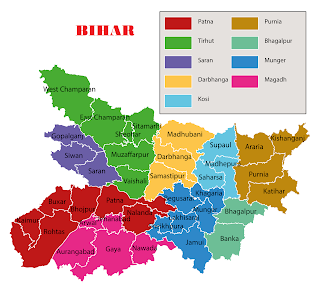 |
| EARLY HISTORY OF BIHAR |
Many of Sanatana ( Eternal ) Dharma or Hindusim's ancient myths and Legends are associated with Bihar. The region holds the merit for bringing forth numerous regions. It was here that Prince Gautam accomplished enlightenment and transformed to Buddha at the present Bodh Gaya, a town in central Bihar and gave birth to Buddhism. The district is brimming with stays of the religious communities known as Stupa. Lord Mahavira, the author of Jain religion was also born here and attained nirvana. The site is just a couple of miles toward the south-east of Patna at present the town of Pawapuri.
The tenth Guru of the Sikh religion, Guru Gobind Singh Ji was born here and became a proficient Sikh saint. A grand Gurdwara ( Sikh temple ) - Takhat Sri Harmandir Ji Sahib also regarded as Patna Sahib was constructed in the eastern Patna to celebrate the Guru's memory. The Gurdwara is one of the five holiest spots of worship ( Takhat ) for Sikhs.
The Magadh and Licchavi kingdoms thrived during 7th and 8th century B.C. The rulers of this implemented an arrangement which is not only a predecessor of modern art of statecraft but of the linkage of statecraft with the financial aspects. A counsel to the Magadh King Chandragupta Maurya, Kautilya ( also regarded as Chanakya ) and the creator of Arthashastra, the first treatise on the modern economics also lived here.
The famous Mauryan king - Ashoka was the first to set firm doctrines for the effective administration of people in around 270 B.C The doctrines were inscribed on stone columns and placed across the kingdom. The column was delegated with the statue of at least one line sitting over a platform which was shown with sing of wheels. The lion denoted strength, wheel denoted eternal nature of truth, hence the name Dharma Chakra . This figure of lions, on a platform, with engravings of a wheel, was adopted as the official symbol of the independent Republic of India in 1947. Dharma chakra is also infused in the national flags of india Remnants of these pillars still exist at Lauriya - nandan Grah in the district of West Champaran and at Vaishali.
Set-up in Bihar - Nalanda ( 5th century ) and Vikramshila ( 8th century ) are famous centres of learning. They are considered to be the oldest international and secular universities that imparted knowledge and wisdom to students from across the borders.
For the Hindu pilgrims, Gaya standouts as the most sacred Destination for offering prayers to ancestors. Ramayana and Mahabharata, the fantastic sagas of India, still have numerous unforgettable tales associated with different places in Bihar. The creator of Ramayana, Valmiki was also a native of Bihar region. Sufism also developed in Bihar becase a significant number of Sufi saints stated spreading peace and brotherhood between Hindus and Muslim. The Sufis settled here durning the Islamic period. Sufi saints like Imam Taj Faqih from Maner, Shihabuddin Pir Jagiot are some populer names. The Qadri order, presently considered to be one of the central Sufi orders in the state, had one of the most notable representatives, Syed Muhammad of Amjhar Sharif, situated in the Aurangabad district of Bihar.
Comments
Post a Comment